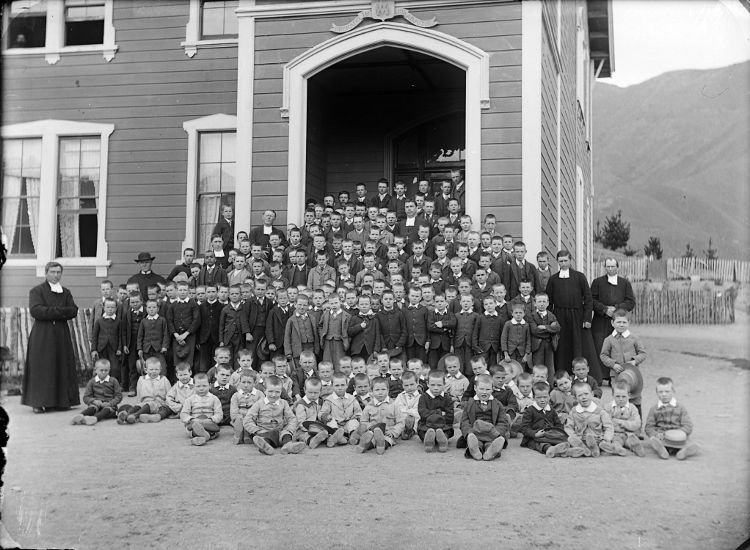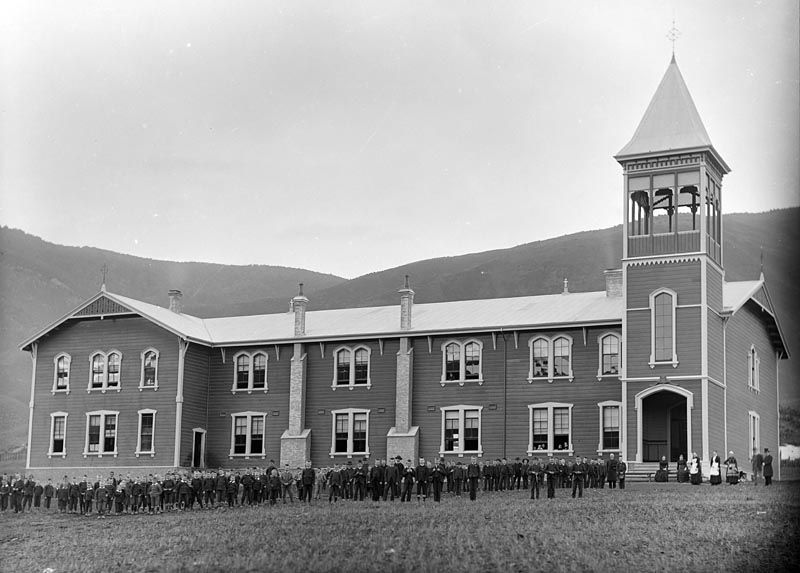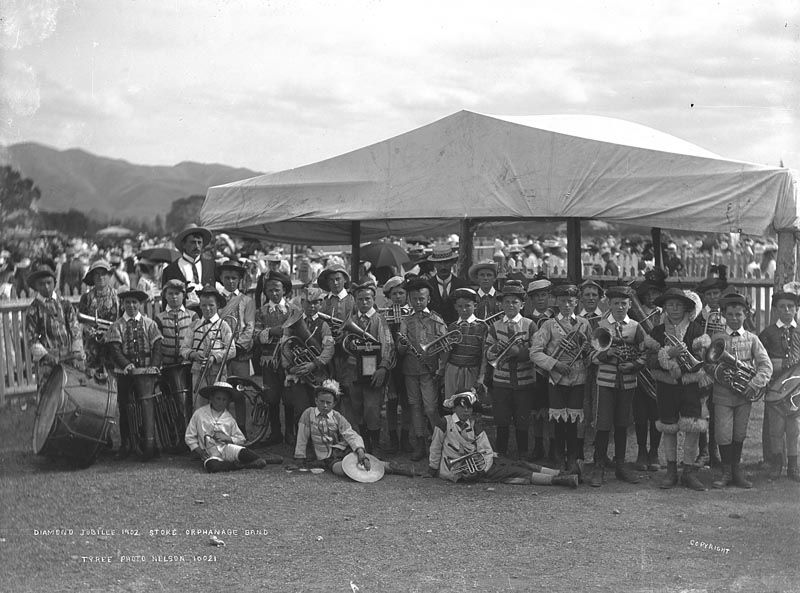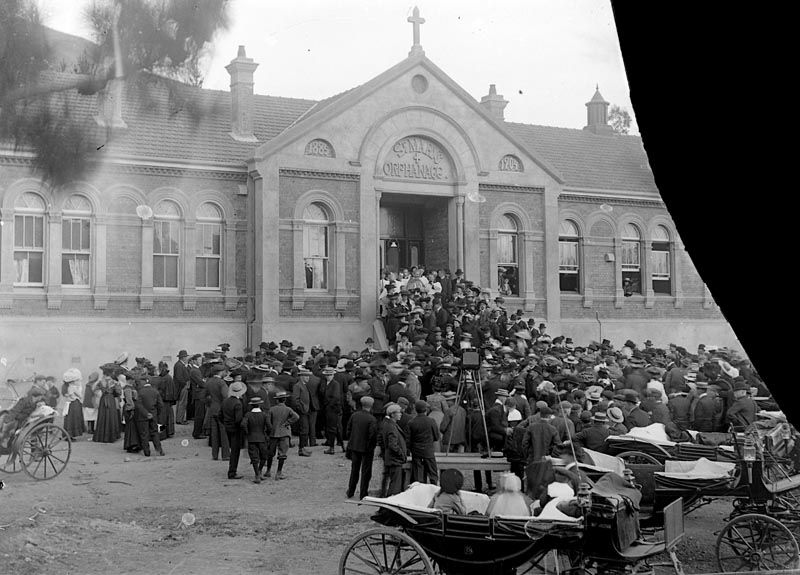Nelson's orphanages and children's homes
A brief history of Nelson orphanages, plus the Stoke Orphanage scandal
The Nelson region has supported homes for children since the 19th Century. Details and research resources about these institutions have been provided at the end of this story. Each institution has its own stories to tell. We feature one of these stories.
Stoke Orphanage Scandal
St Mary's orphanage, a Catholic Institution, was established with good charitable intentions, but scandal (or as the Catholic newspaper, the Tablet described it: "persecution"1) was to send the Marist Brothers packing in 1900.
"The Orphanage" was established by Father Garin. It had three branches: Manuka St. (1872-1945), Stoke Industrial School, Ngawhatu Valley (1886-1910) and Sunnybank, which became Garindale, and operated from 1941-1988.
In 1884 the branch in Stoke was named St. Mary's Orphanage, but was gazetted as St Mary's Industrial School - a privately run, Roman Catholic, reform school.2 In January 1889, after management problems, Archbishop Redwood asked the Marist Order to take charge of the institution, which now had up to 180 boys aged seven to seventeen.3
At the turn of the 20th century, an orphan's lot was not a happy one. The inmates of orphanages were often the children of unmarried women, or were placed in orphanages because of desertion or the death of parents. Orphans endured patronising attitudes, social stigma, and their thoughts and feelings were rarely acknowledged. Orphanages were prepared for and pre-warned about official visitors, so the public generally did not know what actually went on inside.4 St Mary's proved to be a very badly run institution under the Marist Brothers' French lay-teaching order, which took on the management of the institution in 1889 with evident abuse and neglect of the boys.
In May 1900, two boys ran away from the Industrial School (St Mary's Orphanage) Stoke. When they were caught, one of the absconders, James Maher, said he would prefer to be whipped by police than returned to the orphanage. Rumours of excessive punishment circulated and on May 30, members of the Nelson Charitable Aid Board paid a surprise visit.5 "I have never seen such a collection of oddly dressed youngsters before or since," said board member, Charles Harley.6
The board members were shown around by Brother Augustine. Refusing to be diverted by the evasive Brothers, they eventually uncovered five tiny, dark cells where naughty boys were imprisoned and flogged. In one of the cells, they found Maher, who burst into tears as soon as the door was opened.7
The Charitable Board found plenty to be unhappy about. It was evident that the boys were beaten on the hand with supplejack which was ‘freely used and without doubt, in some cases with great severity'. Solitary cell imprisonment could last for up to three months. They charged that: there were no women to care for such young boys, punishment was too severe, food was inadequate and of poor quality, clothing was insufficient and manual labour was sometimes too hard.8
The diet was unvarying. The orphanage ran up to 1000 sheep on the orphanage farm, with two animals killed each day: the hind legs for the brothers, and the rest thrown into a pot of Irish stew. The boys were often hungry and stole scraps from the pig buckets, or ate raw turnips, potatoes and carrots, which they found in the grounds.9
A Royal Commission of Enquiry was appointed to investigate the School. It found that the food and clothing were not ideal but adequate and that the farm work the boys were required to do was not too arduous. However, they did state that the orphanage and children were dirty and that punishment was too severe. They also recommended that more women should be on the staff and that the boys should receive more technical training.10
As a result of the enquiry, The Industrial Schools Act was amended and a wave of anti-Catholic hysteria swept the country. The Brothers left the orphanage in September 1900 and a lay-staff was appointed.11
On 27 April 1903, fire destroyed the wooden orphanage also killing an eight-year-old inmate, William Wilson. A new brick orphanage opened on 24 May 1905 with 100 boys and facilities for teaching boot making, carpentry, knitting and sewing. It also had a hop garden, a sheep and cattle farm and facilities for teaching boot making, carpentry, knitting and sewing and its own cemetery.12 On the opening of the new building the Tablet said the Royal Commission of Enquiry had "exonerated the Brothers from all allegations of cruelty" and said that "panic legislation was passed by an excited majority of law-makers who sorely needed icebags to their heads."13
By 1908, things were much improved, according to the Tablet: "On Sunday, August 2, the boys of St. Mary's Orphanage, Stoke", spent a very "enjoyable afternoon, thanks to some kind lady friends.... A capital programme of sports was arranged and several events were keenly contested by the boys, who entered into the day's proceedings with all the zest and earnestness of youth..... The day was brought to a happy close by evening devotions in the beautiful chapel attached to the orphanage."14
But life did not really change for Nelson's most powerless citizens. The Stoke Orphanage became a state training school for delinquent boys and ‘Raymond', who arrived in 1917, reported constant hunger, bad food (stew with maggots) and hard work on the orphanage farm.15 In 1919 the institution was closed due to Government policy changes.16
More on St Marys Orphanage in Nelson and Stoke [PDF] or contact St Mary's Parish archive
Nelson's Sisters of the Mission began caring for orphans at Manuka Street in 1872. When the orphanage was gazetted under the Industrial Schools Act of 1882, children of other denominations were accepted.
Sunnybank17 operated almost self-sufficiently on 18 hectares of agricultural land from the 1940s until the late 1980s. As a Nelson PhotoNews story of September 196318 described it, five Sisters of the Mission and a priest tended to the material, educational and spiritual needs of up to 50 boys aged between 5 and 15, not to mention 13 milking cows and a flock of sheep.
Other orphanages established in the Nelson region
Wallis Family Children's home, also known as Hulmers (Private, Motueka, 1867-1887)
For more information see:
- Mairs, E. (1988) The Wallis family Children's home, Motueka, 1867-1887. Westport, N.Z.: E. Mairs
- Mairs, E. (2007) Wallis, Mary Ann Lake 1821 - 1910'. Dictionary of New Zealand Biography
http://www.dnzb.govt.nz/dnzb/alt_essayBody.asp?essayID=2W6 - Mairs, Elspeth : Collection, 1867-1887. Nelson Provincial Museum Archives
For an image see: Mairs, Elspeth, fl 1980s-2000s :The Wallis Family Children's Home, Motueka [1867-1887, drawn 1980s?]
https://teara.govt.nz/en/photograph/3426/the-wallis-orphanage-motueka
St Andrews Orphanage/ Family home (Church of England & interdenominational from 1923)
This institution had the following branches: Waimea Road, 1887-1911; Kawai Street 1911-1966; Richmond 1967- date.
For more information, see:
- Ault, H.F. (1958) The Nelson narrative. Nelson, N.Z.: Diocese of Nelson, pp212-213
- St Andrews orphanage (1903, January 9) Colonist, p.2
http://paperspast.natlib.govt.nz/cgi-bin/paperspast?a=d&d=TC19030109.2.10 - Wilkins, W.F. (1987). St. Andrews home, 1887-1987. Unpublished typescript. Nelson Provincial Museum
Whakarewa Home (Church of England, Motueka, 1887-1975)
For more information, see:
- Ault, H.F. (1958) The Nelson narrative. Nelson, N.Z.: Diocese of Nelson, pp.207-211
- Ngati Rarua Atiawa Trust : about the trust. Retrieved 28 Oct 2015:
http://www.nrait.co.nz/our-stories/ngati-rarua-atiawa-trust-/ - Whakarewa a trust betrayed (1984, October 1) Lie of the land, p.2
http://www.nrait.co.nz/assets/our-stories/Lie-of-the-Land-landscape.pdf - Wakarewa [sic] orphanage (1896, July 24) Nelson Evening Mail, p. 2
http://paperspast.natlib.govt.nz/cgi-bin/paperspasta=d&cl=search&d=NEM18960724.2.14.1
Note - More information about each orphanage can be found on Papers Past by searching under the names of the institutions.
2010 (updated 2022)
Story by: Joy Stephens
Sources
- Rabid Enemies (1900, December 20) New Zealand Tablet, p.18.
https://paperspast.natlib.govt.nz/periodicals/NZT19001220.2.41 - Bush, R & Wardell, H. S. (1900). Stoke Industrial School, Nelson (Report of Royal Commission On, Together With Correspondence, Evidence and Appendix). Wellington: Government Printer.
http://atojs.natlib.govt.nz/cgi-bin/atojs?a=d&d=AJHR1900-I.2.2.3.8 - Smith, Dawn (1993). The boys in the valley. Journal of the Nelson and Marlborough Historical Societies, 2,(5) pp.21-26
http://www.nzetc.org/tm/scholarly/tei-NHSJ05_05-t1-body1-d4.html - Crawford, P. (1995) Only an orphan : first-hand accounts of life in children's institutions in New Zealand. Lower Hutt [N.Z.] : MJC Pub pp.2-5
- Smith, Dawn
- Ansley, Bruce (1993, 4 Dec) In the brothers' keeping. Listener, 1993; 141 (2800), pp.24-26
- Ansley
- Stoke Industrial School, Nelson (Report of Royal Commission on, together with correspondence, evidence, and appendix) Govt. Print 1900 as monograph, or, in NZ. Appendices to the Jnls of the House of Representatives, pp.2-3
- Stoke Industrial School: pp.19-21. https://paperspast.natlib.govt.nz/parliamentary/AJHR1900-I.2.2.3.8
- Smith, Dawn
- Webby, M.M. (1991) From prison to paradise - genealogy of Ngawhatu Hospital previously known as Nelson Lunatic asylum 1840-1991 and St Mary's Orphanage of Stoke. Nelson: The Author. (no page numbers)
- Smith, Dawn
- St Mary's Industrial School, Stoke: solemn opening new building at Stoke. (1905, May 29) Colonist, XLVII, (11344), p.6
- St Mary's Orphanage, Stoke. (1908, 13 August) New Zealand Tablet , p.13
https://paperspast.natlib.govt.nz/periodicals/NZT19080813.2.15.2 - Hunt, C. (1982, November 13). Stoke Industrial School. Nelson Mail
- Abolition of Industrial School (1919, June 10) Colonist, p.6
http://paperspast.natlib.govt.nz/cgi-bin/paperspast?a=d&d=TC19190610.2.56 - Postance, P. (2016) Sunnybank - the forgotten boys' home. Journal of the Nelson Marlborough Historical Society (8)2 ,pp.61-71
- A new life at Sunnybank (1963, 14 September) Nelson Photo News. No 35
http://photonews.org.nz/nelson/issue/NPN35_19630914/t1-body-d35.html
Further Sources
Books
- Crawford, P. (1995) Only an orphan : first-hand accounts of life in children's institutions in New Zealand. Lower Hutt [N.Z.] : MJC Pub
http://www.worldcat.org/title/only-an-orphan-first-hand-accounts-of-life-in-childrens-institutions-in-new-zealand/oclc/37742077 - Harris, A, (1994) The beauty of your house. Nelson, N.Z.: St Marys Parish
http://www.worldcat.org/title/beauty-of-your-house-the-nelson-catholic-parish-1844-1994/oclc/39968304 - Hunt, C. (1981) Speaking a silence. Wellington, N.Z.: Reed, p.14-31
http://www.worldcat.org/title/speaking-a-silence/oclc/9576171 - O'Connor, M.E. (2008) Salisbury School : a lesson in special education. Nelson, N.Z.: Te Whanau o Salisbury
http://www.worldcat.org/title/salisbury-school-a-lesson-in-special-education/oclc/313744700 - Stoke Industrial School, Nelson (report of Royal Commission on, together with correspondence, evidence, and appendix) Govt Print 1900. [held Nelson Public Library or, in NZ. Appendices to the Jnls of the House of Representatives]
- Webby, Majorie M. (1991). From prison to paradise - genealogy of Ngawhatu Hospital previously known as Nelson Lunatic asylum 1840-1991 and St Mary's Orphanage of Stoke. Nelson: The Author.
http://www.worldcat.org/title/from-prison-to-paradise-genealogy-of-ngawhatu-hospital-previously-known-as-nelson-lunatic-asylum-1840-1991-and-st-marys-orphanage-at-stoke/oclc/156415681
Newspapers
- Ansley, Bruce (1993, 4 Dec). In the brothers' keeping. Listener, 1993; 141 (2800), 24-26
- Arnold, Naomi (2014, 24 May) Hard times and healing. Nelson Mail, p15
http://www.stuff.co.nz/nelson-mail/features/weekend/10080478/Hard-times-and-healing - Basham, Laura. (20/10/1999) Salvation Army hopes to buy Garindale. Nelson Mail, p.2
- A new life at Sunnybank (1963, 14 September) Nelson Photo News. No.35
http://photonews.org.nz/nelson/issue/NPN35_19630914/t1-body-d35.html - Roll call at orphanage. Dominion Post. 21/04/1999, p2
- Smith, Dawn (1993). The boys in the valley. Journal of the Nelson and Marlborough Historical Societies, 2,(5), pp.21-26
http://www.nzetc.org/tm/scholarly/tei-NHSJ05_05-t1-body1-d4.html - Wetere, Mere. (1997, 22 Mar). Grave raid stirs stones of orphans' neglect Evening Post, p.14
Websites
- Catholic Industrial schools (1907, 3 October). New Zealand Tablet, XXXV (40), p.35
https://paperspast.natlib.govt.nz/periodicals/NZT19071003.2.56 - The Cyclopedia of New Zealand : industrial, descriptive, historical, biographical facts, figures, illustrations. V.5 Nelson, Marlborough and Westland provincial districts.(1897-1908) Wellington, N.Z.: Cycyclopedia Co, p.61
http://www.nzetc.org/tm/scholarly/tei-Cyc05Cycl-t1-body1-d1-d1-d12.html - St Mary's Industrial school, Stoke. (1900, 1 August) Colonist, XLIII, (9856), p. 2
https://paperspast.natlib.govt.nz/newspapers/TC19000801.2.9 - St Mary's Industrial school, Stoke: solemn opening new building at Stoke.(1905, 29 May) Colonist, XLVII, (11344), p.6
https://paperspast.natlib.govt.nz/newspapers/TC19050529.2.24.13 - St Mary's Orphanage, Stoke. (1908, 13 August) New Zealand Tablet , p. 13
https://paperspast.natlib.govt.nz/periodicals/NZT19080813.2.15.2 - Stoke Industrial School, Nelson (Report of Royal Commission on, together with correspondence, evidence, and appendix)., Appendix to the Journals of the House of Representatives, 1900 Session I, E-03b.
https://paperspast.natlib.govt.nz/parliamentary/AJHR1900-I.2.2.3.8
Maps
- St Mary’s Boys and Girls Orphanage Registers & Sunnybank Boys Home Registers. Some Registers as early as 1850. Held St Mary’s Parish Archives/Museum, 18 Manuka Street, Nelson. Phone NZ 03 5489527 (or contact the Archivist, St Mary's Parish, P.O.Box 37, Nelson)



